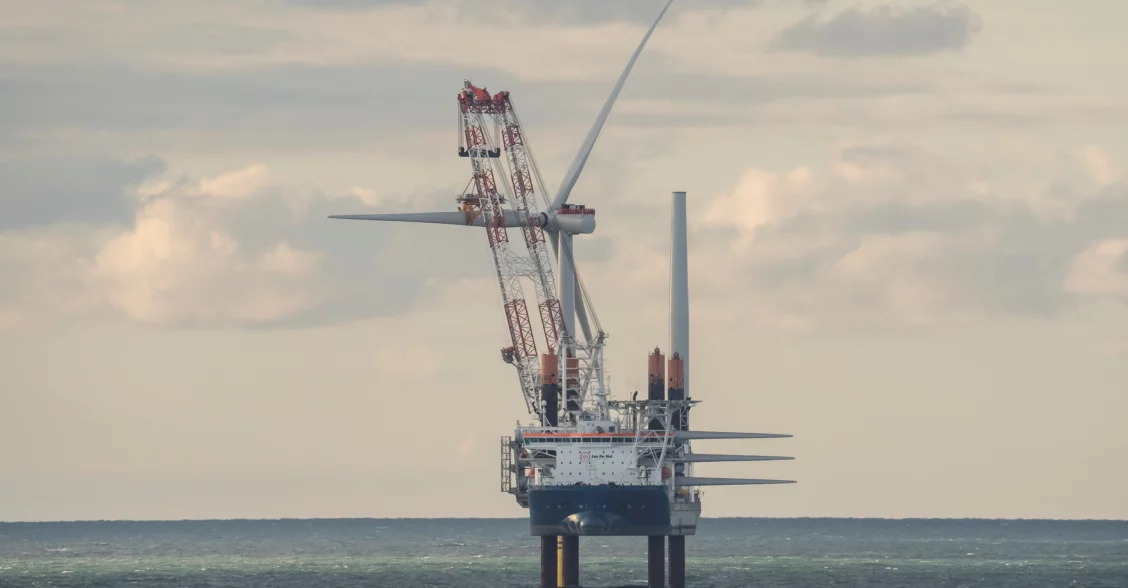“We’ve reached a milestone,” says Vattenfall’s project director, referring to the Vesterhav Syd and Vesterhav Nord wind farms, which are almost ready to supply power to 340,000 households. The Vole au vent installation vessel recently installed the remaining wind turbines, which were shipped from Esbjerg.
Forty-one 193-metre-high turbines have now been erected some five to ten kilometres off the west coast of Jutland. They rise majestically on the horizon and may be seen from the coast in Harboøre and all the way to Hvide Sande about 75 kilometres further south.
The turbines were not yet ready just a few weeks ago. The last of the components were still aboard the Vole au vent, which was moored in the harbour at Esbjerg, while the captain gave a tour of his ship.
“You’re looking at the last of the blades to be installed on this project,” said Captain Henno Bloem with a smile while nodding towards the deck from his command post on the bridge. He was pointing to the blades securely strapped on the deck – so big that they made the men walking around them look like ants.
The boom on the crane can reach up to 105 metres. The working height on this project was 17 metres above sea level when the Vole au vent places her legs on the sea floor to allow the crane to lift blades, nacelles and towers into place.
From June onwards, the captain was a member of the crew who installed the Vesterhav Nord and Vesterhav Syd turbines at sea. Forty-one 8.4 MW wind turbines. This year’s only offshore wind project in Denmark. According to Vattenfall, the energy company which owns the project, the 41 turbines will have a total output of 344 megawatts. This is enough to cover the annual power consumption of more than 350,000 Danish households.
“We’ve reached a milestone,” says Vattenfall’s project director Mathilde Damsgaard. The wind farms are all but ready to operate; all that is needed now are the final installations and technical tests.
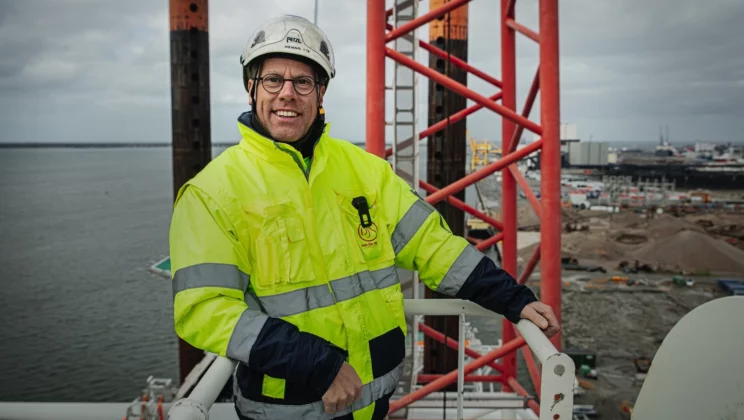
Captain Henno Bloem gave a tour of his ship when docked at Port Esbjerg.
An unofficial speed record
The turbines were installed from the Vole au vent, a 140-metre-long and 40-metre-wide vessel.
According to the captain, the installation project out of Esbjerg was running smoothly and largely on schedule. During the early stage in June while the weather was calm, the crew slowly began to operate like a well-oiled machine. So well-oiled, in fact, that it took a mere 13 hours to install one turbine.
However, as is often the case, something had to go wrong and on this occasion, a due to an unexpected delay the crew had to bring some of the blades back instead of installing them on the turbine. And then the weather changed.
“Something like this almost always happens, but the project has been managed really well,” the captain explains.
Still, it has been a long time from the project got the go-ahead and until the turbines were installed off the coast of Jutland.
The political decision was taken through the Energy Agreement reached in 2012, and Vattenfall won the tender in December 2016. In other words, the project has been a long time coming and was delayed while neighbour complaints had to be dealt with.
As a result, Vattenfall changed the location of the wind turbines, moving them as far off the coast as possible. But now the wind farms are almost ready.
Project nearing its completion
The preparations for the installation began in January 2023. The offshore construction site was marked up with buoys, and in February, the monopile protecting the turbine foundations was put in place. Next followed the construction of the foundations, which proceeded according to plan and was completed on 28 April.
April marked the start of the installation of cables on the beach, where the cable comes ashore. The laying of cables offshore began in July.
This is complex work, but it is now very nearly complete: all cables have been laid to connect the turbines, encased in the foundations and firmly secured.
Ten turbines are attached to a transmission line, which connects to land. All four land cables are now also in place. It was a challenge to embed them deep enough into the sea floor in order to ensure that they would be secure and stay in position for the next 25 to 30 years. Several ships were involved in this part of the project.
“The offshore work on cables close to the coast, the so-called wave breaking zone, is highly sensitive to the height of waves. We can’t work on the last details if we’ve got waves of more than 80 centimetres, and that can be a challenge at this time of year,” says Damsgaard.
As project director of Vesterhav Nord and Vesterhav Syd, she heads up the steering committee running the entire team of 90 people working hard to deliver the project.
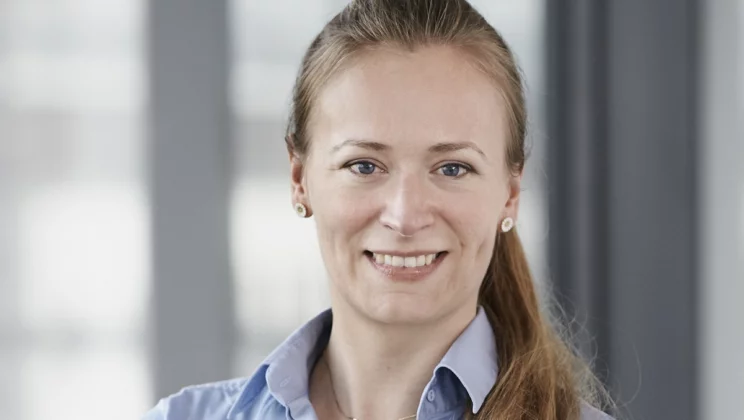
“We’ve reached a milestone,” says Vattenfall’s project director Mathilde Damsgaard.
One tower left on deck
A couple of weeks ago, back on the Vole au vent, Captain Bloem was down on the deck looking at the final tower to be installed. It was on the deck next to the last of the blades.
He nodded to a colleague walking by on deck who was one of the 74 people on board, 35 of whom were based on the ship, while the rest were involved in the installation at sea. Only four of them are women.
The entire crew was replaced before the last voyage. Captain Bloem is on the ship for six weeks at a time and then has a similar period off afterwards.
The ship lay in the harbour for just over a week, waiting for the weather to improve before the last of the components were installed.
Next, the ship sailed back to Esbjerg and had her wind turbine installation equipment dismantled.
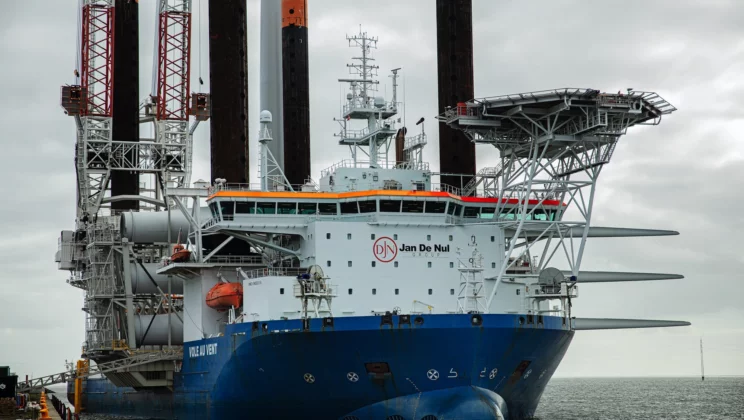
Vole au vent is a 140-metre-long and 40-metre-wide vessel.
The only offshore-wind project in Denmark this year
In addition to getting the gigantic wind turbine parts in place, connecting and hooking up the electronic components is also a lot of work. That is still ongoing and will continue for some time yet. The cable systems must be tested and tested thoroughly in the turbines, while the autumn winds are pounding on the blades and the towers.
“Working on a wind turbine makes for a rather special working environment,” says Damsgaard. The nacelles at the top of the towers can sway several metres back and forth.
She is proud of her project and quite pleased with its current status.
“This is the only offshore-wind project in Denmark this year, and it’s been a long time in the making. Vattenfall has been working on it since 2016, and we’ve hit several bumps along the way,” she explains.
For example, Vattenfall has cooperated closely with local residents and local authorities. In addition, holiday home owners and local residents have been able to buy shares and become co-owners of the project. That has made the process rather special.
“But it’s also been a learning curve,” says Damsgaard.
The vessel’s crane can lift 1,500 tonnes
The Vole au vent has a huge crane on deck that can easily take your breath away. It is the size of a multi-story building in a big city and it is incredibly powerful. It has a lifting capacity of 1,500 tonnes, equal to the weight of some 300 elephants – in one go. That makes it future-proof for lifting nacelles and towers, which are ever growing in size. The components for the Vesterhav Nord and Vesterhav Syd wind farms have not posed a problem.
Captain Bloem has been at sea for many years, but he has only been captain of the Vole au vent for the past two.
“I do it because I love the job,” is the simple answer as to why he is so deeply involved in the installation of wind turbines. He is still fascinated by the huge components that must be placed out at sea within tolerances of mere centimetres.
He has been involved in installing at least five similar offshore wind farms and he expects to see many more.
And he certainly would not mind if they were shipped out of Esbjerg.
“There’s a highly professional setup at Port Esbjerg. Unlike in other ports, you don’t need a pilot which often complicates the process. Also, as I stand here on the bridge looking out over the harbour, almost all the projects I can see are wind related. That’s a very nice view,” says Captain Bloem.
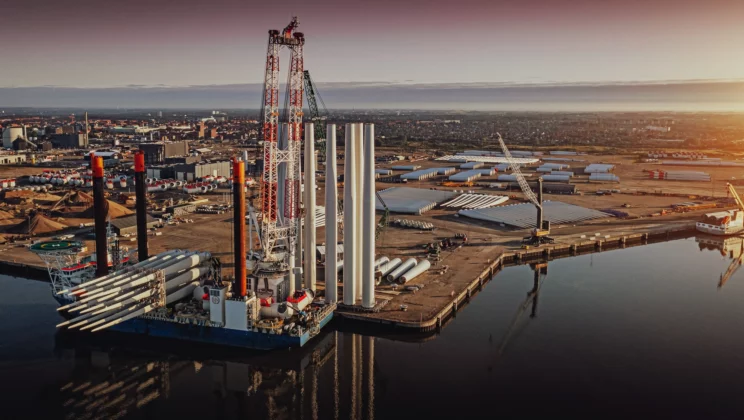
The vessel’s crane can lift 1,500 tonnes, equal to the weight of some 300 elephants.
Complex project
The Vesterhav Nord and Vesterhav Syd wind farms made for a particularly complex project, because Vattenfall brings the power directly ashore to an onshore transformer. In the past, Danish projects usually involved offshore transformer stations. The onshore solution has produced a few extra challenges.
“We’ve struggled with this, but have had excellent cooperation between the parties and the suppliers.” Our challenges have ranged from Covid-19 to the war in Ukraine and elevated steel prices, but I have also experienced an extreme willingness from industry players to make it a success,” says Damsgaard.
344 MW out of 60 GW
Captain Bloem will now be sailing the vessel to Ostend after which she is due to go into dry dock to be sandblasted and painted. Installation vessels are in high demand. The sister ship, the Voltaire, is booked until the end of the decade. The Vole au vent can carry four turbine towers, four nacelles and twelve blades at a time.
Damsgaard proudly notes that the goal is within reach – even though, at 344 MW, this is not an exceptionally large project, considering the fact that the EU is aiming to have 60 GW installed by 2030 and the current total capacity is less than 15 GW.
“However, it’s a step in the right direction, and the turbines of Vesterhav Nord and Vesterhav South will also provide power to Germany,” explains Damsgaard.
She also has praise for Port Esbjerg.
“It’s clear that Esbjerg has a lot of experience with this type of project. We’ve had no unforeseen challenges from that end. It’s a robust and well-functioning part of the project,” she says.
Vattenfall expects Vesterhav Nord and Vesterhav Syd to be fully connected to the grid by 31 December 2023.
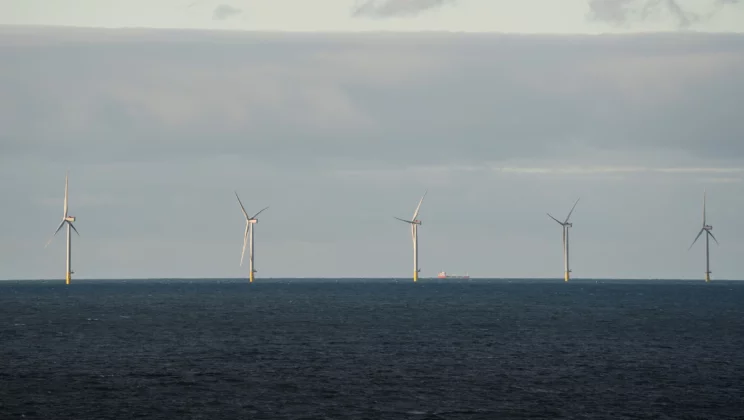
Forty-one 193-metre-high turbines have now been erected some five to ten kilometres off the west coast of Jutland.
Go to overview
